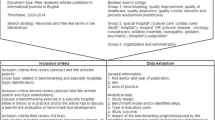Abstract
Introduction
Orthopedics has its own specificities in terms of costs, primarily related to the purchase of orthopedic devices and usage of operating rooms, as well as in terms of management issues connected with the organization of medical staff, nursing care, and ancillary support. This paper analyzes the application of benchmarking techniques in the health care sector. It discusses opportunities and limits of benchmarking in the public service sector, focusing on orthopedics; a sector characterized by its own specificities in terms of costs, organization, and management.
Methods
This paper takes into consideration the first Italian benchmarking project realized in orthopedics that involved three Italian centers of excellence: IRCCS Istituto Ortopedico Galeazzi (Milan), Azienda Ospedaliera CTO—Maria Adelaide (Turin), and IRCCS Istituto Ortopedico Rizzoli (Bologna). It aimed to carry out a comparative analysis in order to identify the best performance and to improve the service and the organizational effectiveness.
Results
Relevant differences were assessed between the three hospitals involved and possible areas of innovation were detected.
Discussion
The results of the study highlight the significant reproducibility of benchmarking techniques due to the opportunity of standardizing procedures. Moreover, the differences concerning location, ownership, supply, purchasing, and accreditation processes, each one a potential limitation, provide information that is helpful in identifying relative gaps and that suggest paths leading to improvement.

Similar content being viewed by others
References
Camp RC (1992) Learning from the best leads to superior performance. J Bus Strateg 13(3):3–6
Spendolini MJ (1992) The benchmarking book. Amacon Books, New York
Spendolini MJ (1992) The benchmarking process. Compens Benefits Rev 24:4–5
Cross R, Iqbal A (1995) The rank xerox experience: benchmarking ten years on, in benchmarking: theory and practice. Edito da Asbjorn Rolstadas. Chapman & Hall, London
Watson H (1993) Strategic benchmarking: how to rate your company's performance against the word's best. Wiley, Chichester
Hutubessy RCW, Baltussen RMPM, Tan Torres-Edejer T, Evans DB (2002) Generalised cost-effectiveness analysis: an aid to decision making in health. Appl Health Econ Health Pol 1(2):89–95
Iorio R (2007) Cost analysis and containment in primary total hip arthroplasty. Curr Opin Orthop 18(1):8–12
Upshur REG, Moineddin R, Crighton EJ, Mamdani M (2006) Seasonality of service provision in hip and knee surgery: a possible contributor to waiting time? A time series analysis. BMC Health Serv Res 6:22
Burns LR, Housman MG, Booth RE Jr, Koenig A (2009) Implant vendors and hospitals: competing influences over product choice by orthopaedic surgeons. Health Care Manag Rev 34(1):2–18
Kiefe CI, Allison JJ, Williams OD et al (2001) Improving quality improvement using achievable benchmarks for physician feedback: a randomized controlled trial. JAMA 285(22):2871–2879
Radensky PW (1999) Application of legal and regulatory rules and policies to benchmarking systems. J Ambulatory Care Manag 22(3):24–27
Jackson DW (2006) Benchmarking in orthopedic surgery does not recognise diverse groups. Orthop Today 26:82
Cooper R, Kaplan RS (1988) Measure costs right: make the right decisions. Harv Bus Rev 66(5):96–103
Miolo P, Vitali D, Nuti S (2004) Sperimentazione dell’activity based management nella sanità pubblica. Franco Angeli, Torino
Adam T, Evans DB, Murray CJL (2003) Econometric estimation of country-specific hospital costs. Cost-eff Resour Allocation 1:3
Dreinhöfer K, Dieppe P, Stümer T et al (2006) Indication for total hip replacement: comparison of assessments of orthopaedic surgeons and referring physicians. Ann Rheum Dis 65:1346–1350
Stargardt T (2008) Health service costs in Europe: cost and reimbursement of primary hip replacement in nine countries. Heal Econ 17:S9–S20
Conflict of interest
The authors are not aware of any potential conflicts that may bias their work. The manuscript is a nonprofit study based on the application of managerial benchmarking. Therefore, conflicts of interest should not exist. The study presented in this manuscript is of an observational nature and is based on a managerial benchmarking, without any direct involvement of patients. As far as the authors are aware, the study raises no ethical issues.
Author information
Authors and Affiliations
Corresponding author
Rights and permissions
About this article
Cite this article
Porazzi, E., Zagra, L., Restelli, U. et al. The first Italian benchmarking project in the field of orthopedics. Eur Orthop Traumatol 3, 155–160 (2012). https://doi.org/10.1007/s12570-012-0123-9
Received:
Accepted:
Published:
Issue Date:
DOI: https://doi.org/10.1007/s12570-012-0123-9




